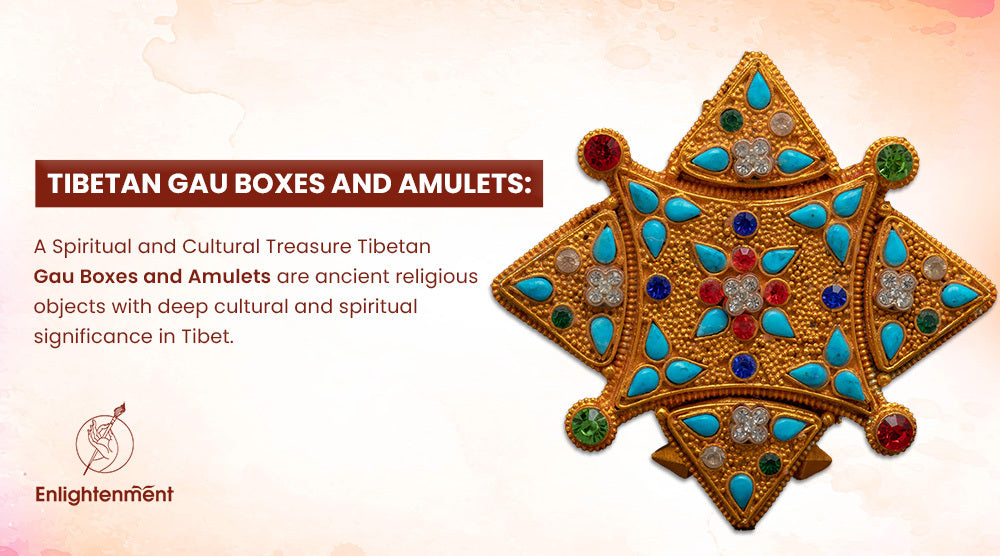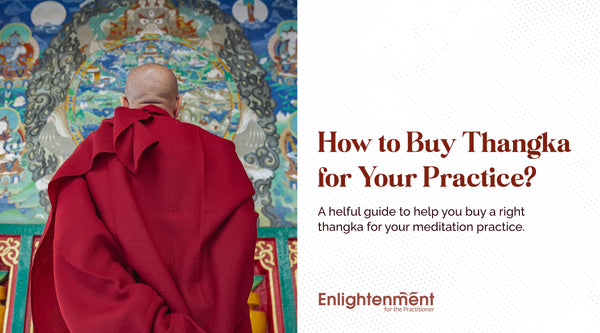Tibetan Gau and Amulet Boxes: A Spiritual and Cultural Treasure
Tibetan Gau and Amulet Box are ancient religious objects with deep cultural and spiritual significance in Tibet. These small, portable shrines or containers are filled with sacred items such as mantras, relics, and holy images, making them powerful talismans of protection, healing, and blessings. For Tibetans, carrying a Gau Box or Amulet expresses devotion, faith, and identity and is an essential tool for spiritual practice and everyday life.
History of Tibetan Ghau Boxes and Amulets
These spiritual and cultural treasures have a long and rich history dating back to the 7th century when Buddhism was introduced to Tibet. Originally, Ghau Boxes were made of leather or cloth and stored medicinal herbs or precious objects, such as jewelry or relics of important lamas. Later, as Buddhism became more widespread, Gau Boxes were adopted as portable shrines and amulets filled with sacred objects and worn around the neck or carried in pockets.
During the 16th and 17th centuries, Ghau Boxes and Amulets became increasingly ornate and intricate, with detailed carvings, embossed designs, and precious stones. They were made of various materials, such as silver, gold, brass, copper, and iron, and adorned with images of deities, mandalas, animals, and auspicious symbols.
Tibetan soldiers often wore them to protect them from harm in battle, and Tibetan monks and laypeople also used them for spiritual protection and healing. Over time, they became more elaborate and intricate, featuring unique designs and symbols inspired by Tibetan culture and mythology.
The design and meaning of these cultural items are deeply rooted in Tibetan Buddhist iconography, cosmology, and mythology. They represent a fusion of the ancient Bon religion and Tantric Buddhism, incorporating shamanic practices, magic, and symbolism.
Making of Tibetan Ghau Boxes & Amulets
Both Ghau Boxes and Amulets are made by skilled artisans who use various materials, including silver, brass, and copper. The boxes and amulets are decorated with intricate designs and symbols, and precious stones such as turquoise, coral, and amber are often incorporated to enhance their beauty and spiritual significance. Making a Gau box and Amulets is complex and can take several months, as each box is crafted with great care and attention to detail.
Symbols and Designs
The symbols and designs are inspired by Tibetan culture and mythology and have unique meanings and significance. The 8 auspicious symbols of Buddhism, the lotus flower, and the endless knot are some of the most common symbols on Gau boxes. The intricate designs feature geometric patterns, animals, and other motifs inspired by Tibetan culture and mythology.
Types of Tibetan Gau Boxes and Amulets
Tibetan Ghau Boxes and Amulets come in many shapes, sizes, and styles, each with its unique meaning and purpose. They can be made of metal, wood, bone, or stone and decorated with intricate designs and symbols. Here are some of the most popular types:
Tibetan Gau
Click here to view our Tibetan Ghau Boxes
Miniature Ghau Boxes: These are small-sized Ghau boxes designed to be worn as pendants or hung around the neck. They are usually intricately decorated with filigree work, gemstones, and symbolic motifs. Miniature Gau boxes are portable and allow individuals to carry their sacred objects or relics close to their bodies.
Ritual Ghau Boxes: These are more prominent and used in ceremonial or ritualistic practices. They often contain specific religious objects like miniature statues, ritual implements, or consecrated substances. Ritual Gau boxes may be ornately embellished and are considered sacred items used in elaborate rituals.
Healing Ghau Boxes: These Ghau boxes are believed to possess healing properties. They may contain specific herbs, medicinal substances, or written prayers related to healing and well-being. Healing Gau boxes are used by individuals seeking remedies for physical ailments or invoking blessings for health and recovery.
Traveler's Ghau Boxes: These Ghau boxes are designed with the needs of travelers in mind. They are compact, lightweight, and easily portable. Traveler's Gau boxes often include essential religious objects, such as protective amulets or written prayers, to ensure spiritual well-being during journeys.
Family Ghau Boxes: These Ghau boxes hold significant importance within families and are passed down through generations. They may contain relics, precious objects, or sacred scriptures that hold ancestral or familial connections. Family Gau boxes serve as cherished heirlooms and symbols of spiritual heritage.
Wealth and Prosperity Ghau Boxes: These boxes attract wealth, abundance, and prosperity. They may include symbolic representations of wealth, such as auspicious symbols, mantra inscriptions, or precious gemstones. Wealth and Prosperity Gau boxes are believed to bring financial well-being and success.
Tibetan Amulet
Click here to view our Tibetan Amulets
Mantra Amulets: These are sacred mantras, such as the Om Mani Padme Hum mantra, considered one of the most powerful mantras in Tibetan Buddhism. The mantras are often inscribed on metal, wood, or stone amulets and worn for protection, spiritual purification, and invoking blessings.
Tibetan Symbol Amulets: These symbols hold significant meaning in Tibetan Buddhism. Examples include the Eight Auspicious Symbols (such as the conch shell, lotus flower, and endless knot), the Tibetan Dorje (symbol of spiritual power), and the Tibetan Om (symbol of the universal sound). These symbols bring positive energy, good fortune, and protection.
Thangka Amulets: Thangka is a traditional Tibetan Buddhist painting on fabric or paper. Thangka amulets are small replicas of these intricate paintings encased in protective coverings. They depict deities, mandalas, or sacred scenes and are believed to carry the blessings and spiritual energy associated with the original artwork.
Protection Amulets: These amulets are specifically designed for personal protection against negative influences and energies. They may feature deities known for their protective qualities, such as Tara (goddess of compassion) or Mahakala (protector deity). Protection amulets are worn or carried to ward off evil spirits, accidents, and other harm.
Medicine Amulets: Medicine amulets are believed to have healing properties and are associated with traditional Tibetan medicine practices. They may contain medicinal herbs, minerals, or sacred substances, enclosed in protective casings. Medicine amulets are worn or carried to promote physical well-being, prevent illness, and bring about balance and harmony.
Elemental Amulets: These are connected to nature's elements and are believed to harness their energies. For example, an amulet representing a snow lion symbolizes courage and strength, while an amulet representing a dragon represents power and wisdom. Elemental amulets are worn or carried to invoke the qualities associated with the respective elements.
The Significance of Tibetan Gau and Boxes
Tibetan Gau Boxes & Amulets have significant religious and cultural significance in Tibet. They are an essential part of Tibetan Buddhism and are believed to offer spiritual protection, healing, and blessings. These are also used in meditation and rituals and are often given as offerings or gifts to lamas or deities.
The consecration and empowerment of these items are essential to their spiritual significance. Consecration involves the purification of the Gau Box and the filling it with sacred objects, such as relics or prayers. Empowerment consists of the infusion of spiritual energy into the Gau Box through meditation and ritual.
How to Use Tibetan Gau Boxes and Amulets
Tibetan Gau Boxes and Amulets are used for various purposes, from personal protection to spiritual practice. They are considered powerful tools for healing, meditation, and ritual and are believed to bring good luck, prosperity, and blessings.
- Personal Protection
These are often carried or worn to protect against negative energy, evil spirits, and physical harm. They are believed to create a protective field around the wearer, deflecting negative influences and promoting positive energy.
- Spiritual Practice
They are also used as aids for meditation and spiritual practice. They can focus the mind, generate positive energy, and deepen one's connection to the divine. Some Gau Boxes contain specific prayers or mantras, which can be recited during meditation or throughout the day.
- Rituals and Ceremonies
They are integral to Tibetan Buddhist rituals and ceremonies, such as pujas, empowerments, and initiations. They are often used as offerings or gifts to lamas or deities and can be placed on altars or shrines.
Tibetan Gau Boxes and Amulets are beautiful and intricate art pieces and powerful spiritual tools with deep cultural and religious significance in Tibet. They are believed to offer protection, healing, and blessings and are essential to Tibetan Buddhist practice and identity. In modern times, these continue to be cherished and used by Tibetans worldwide and by people of other faiths and cultures who appreciate their beauty, symbolism, and spirituality.
FAQs
- What is the difference between a Gau Box and an Amulet?
Gau Boxes are small, portable shrines or containers made of metal and worn as pendants or attached to clothing. They contain sacred objects such as prayers, relics, or miniature statues of deities. On the other hand, amulets are small, talismanic objects made of various materials and used for protection, healing, or blessings.
- Can anyone wear a Tibetan Gau Box or Amulet?
Anyone can wear a Tibetan Gau Box or Amulet, regardless of their faith or cultural background. However, it is crucial to respect these objects' cultural and religious significance and use them with reverence and intention.
- How do I choose the suitable Gau Box or Amulet?
Choosing the right Gau Box or Amulet depends on your preferences and intentions. Consider the materials, symbols, and images used in the Gau Box or Amulet, and choose one that resonates with you or has a specific meaning or purpose. Obtaining Gau Boxes and Amulets from reputable sources is vital to ensure their authenticity and quality.
- Can Gau Boxes and Amulets be used for non-spiritual purposes?
While Tibetan Gau Boxes and Amulets are primarily used for spiritual purposes, they can also be appreciated for their artistic and cultural value. Many people collect Gau Boxes and Amulets as beautiful and unique jewelry or art pieces.
- Are Tibetan Gau Boxes and Amulets only used by Tibetans?
Tibetan Gau Boxes and Amulets are primarily associated with Tibetan Buddhism and culture. Still, they are also used by people of other faiths and cultures who appreciate their beauty, symbolism, and spiritual significance. In recent years, they have gained popularity in the West as unique and meaningful jewelry and art pieces.


